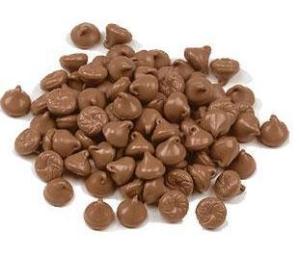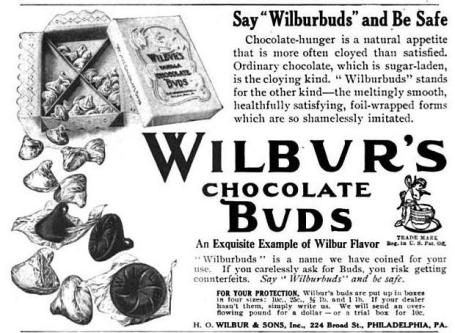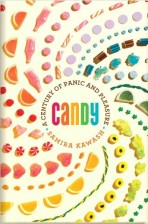Kissing Cousins: the Hershey’s Kiss and the Wilbur Bud
March 1, 2010 at 8:30 am 22 comments
 Hershey’s Chocolate Kisses: do we need to say more? Everybody knows the Kiss. Hershey’s Kiss is certainly one of top contenders for “American Candy Idol.” But today, Candy Professor takes you back to a time when the Kiss was not the Kiss, back to a time when candy brands were still a new idea, and candy makers didn’t always know the best ways to profit from their candy innovations.
Hershey’s Chocolate Kisses: do we need to say more? Everybody knows the Kiss. Hershey’s Kiss is certainly one of top contenders for “American Candy Idol.” But today, Candy Professor takes you back to a time when the Kiss was not the Kiss, back to a time when candy brands were still a new idea, and candy makers didn’t always know the best ways to profit from their candy innovations.
Hershey’s today is one of the major candy companies in the world, boasting annual sales in excess of $4 billion dollars. But around 1900, Hershey’s was one among many contenders for America’s top chocolate maker. The big business in chocolate at that time was not so much direct retail products, but selling various coatings and chocolate ingredients to candy makers large and small. Rivals like Stollwerck Brothers of New York and Chicago, H. O. Wilbur and Sons of Philadelphia, and Rockwood and Co.of Brooklyn were promoting their own chocolate goods, each promising purity, quality and taste unrivaled. Finished candy goods were, for many of these companies, a side line to the real action in wholesale cocoa and chocolate.
Milton Hershey was early to realize the potential for selling eating chocolate on a national scale. He developed his own technique for making milk chocolate and began manufacturing small batches in 1900. Hershey’s chocolate bars were a huge success, and he quickly expanded, moving to an enormous new factory in the town that would come to be known as Hershey, Pennsylvania in 1905. The first full year of manufacture in the new factory, sales of Hershey’s chocolate products topped $1 million; that’s about $24 million in today’s dollars.
By 1907, the year the Kiss was introduced, sales had doubled to $2 million. Even then, Hershey was a major player. But other chocolate houses had their own eating chocolate products. And when Hershey came up with the “Milk-Maid Chocolate Kiss” back in 1907, it wasn’t the only foil-wrapped chocolate bite in town.
Rival chocolate manufacturer H.O. Wilbur and Son had been selling a bite-sized foil-wrapped conical chocolate drop called the “Wilbur Bud” since 1894. You wouldn’t know it today, but back in the 1900s, Wilbur set the standard for those little foil-wrapped chocolates. The candy journal International Confectioner waxed rhapsodic over the beauty and hygiene of Wilbur’s candy in 1914:
Each piece is wrapped separately; they are packed like jewels. A large box of Wilbeurbuds can lie open several days before it is all eaten. … Our little Wilburbuds can’t go stale–each is wrapped in foil.
 It was Hershey that was the copy cat.
It was Hershey that was the copy cat.
And Hershey wasn’t the only one. H.O. Wilbur even went to court in 1909 to try to stop the imitators. One of these might have been Rockwood’s Chocolate Dainties, which were sold four for one cent. In their little foil wrapper, they would have been indistinguishable from Wilbur’s Buds or Hershey’s Kisses or any other similar chocolate.
Unwrapped, the Wilbur Bud was quite distinctive; the bottom of the candy was molded into a flower shape and the letters W-I-L-B-U-R embossed in each petal.
![]() In contrast, the Hershey’s Kiss then as now isn’t much to look at. It is just a plain cone, its bottom flat and unadorned. While this perhaps was less lovely to behold, it did mean the Kiss could be manufactured by dropping the chocolate on a flat belt, rather than needing special molds. This would eventually matter quite a lot, but in 1907 the Kiss’s plain-Jane looks would have been a distinct disadvantage.
In contrast, the Hershey’s Kiss then as now isn’t much to look at. It is just a plain cone, its bottom flat and unadorned. While this perhaps was less lovely to behold, it did mean the Kiss could be manufactured by dropping the chocolate on a flat belt, rather than needing special molds. This would eventually matter quite a lot, but in 1907 the Kiss’s plain-Jane looks would have been a distinct disadvantage.
The decisive moment for the Hershey’s Kiss was 1921, when new manufacturing equipment allowed the foil wrapping to be automated, and also allowed for the inclusion of the “plume” that extends from the top of every Chocolate Kiss. By spring of 1922 Hershey’s was taking out full page ads blaring “Insist upon having the “GENUINE” Sweet Milk Chocolate Hershey’s KISSES. Be Sure They Contain the Identification Tag ‘HERSHEY’S.” The plume was trademarked in 1924, meaning that no other conical foil wrapped chocolate could use the same technique to stand out.
Wilbur, and many other small American chocolate concerns, eventually fell behind Hershey in the race for market share. Milton Hershey was a generous philanthropist as well as a brilliant business man, and the success of the company in dominating the American chocolate scene is a fascinating story of doing well by doing good. Today, Hershey’s Kisses are a multi-million dollar share of the American candy market. And Wilbur’s Chocolate Buds? You can still buy them by mail-order, or out of a little Wilbur Chocolates storefront in Lititz, Pennsylvania.
So why are Hershey’s Kisses called Kisses, anyway? Read more in my next post, “Why a Kiss is Just a Kiss.”
Image of today’s Wilbur Buds from www.wilburbuds.com
Kisses image: http://www.flickr.com/photos/mtsofan/ / CC BY-NC-SA 2.0
Entry filed under: 1890 to WW I, Chocolate, Packaging. Tags: bud, Chocolate, hershey, kiss, wilbur.
22 Comments Add your own
Leave a comment
Trackback this post | Subscribe to the comments via RSS Feed



1. cybele | March 1, 2010 at 11:14 am
cybele | March 1, 2010 at 11:14 am
Since I grew up in the area, I was aware that the Wilbur Bud not only predated the Kiss but was far superior. Plus they came in dark chocolate long before Hershey’s made a version.
Sure they’re more expensive – and don’t come foil wrapped any longer. But well worth the effort to find.
I have to say though, Kiss is a far more appealing name than Bud.
2. CandyProfessor | March 1, 2010 at 11:32 am
CandyProfessor | March 1, 2010 at 11:32 am
I’m hoping to travel soon to Lititz and taste a Bud for myself! I don’t have a good sense of how widely Wilbur Buds were distributed, although my guess would be they weren’t likely to have been sold east of the Mississippi. Hershey was much more aggressive about ramping up production and distributing nationally, and also packaging at 5 cent and 10 cent, which made the candy an easier buy. Wilbur Buds seem to have only been sold in larger boxes. I agree that “kiss” is just the perfect name, but there’s actually a lot more to the “Is it a Kiss” vs “Is it a Bud” story, that’s for Wednesday’s post!
3. cybele | March 1, 2010 at 12:07 pm
cybele | March 1, 2010 at 12:07 pm
As far as distribution before Wilbur was bought out by Cargill, it was rather regional. I know some places up in Boston & Maine carried them in their stores.
In my experience (70s & 80s) in the area, the best place to find Wilbur was at the candy counter at the department stores. Of course now those are gone.
I just noticed – my gravatar icon is a Wilbur Bud!
4. CandyProfessor | March 1, 2010 at 8:38 pm
CandyProfessor | March 1, 2010 at 8:38 pm
Yeah, I grew up in CA and never heard of them until I started this research. But we did have See’s!
5. Mark D. | March 1, 2010 at 12:08 pm
Mark D. | March 1, 2010 at 12:08 pm
Fantastic article! I think I remember this from the Chocolate Wars book, or possibly another book. I think candy theft was rampant in those early years and things were copied. I did download the catalog PDF and I’ll have to place an order for “buds” now.
6. CandyProfessor | March 1, 2010 at 8:37 pm
CandyProfessor | March 1, 2010 at 8:37 pm
Thanks! Can’t wait to read your review.
7. Hershey’s: Why a Kiss is Just a Kiss « CandyProfessor | March 3, 2010 at 8:54 am
[…] Which was first: the Hershey’s Kiss or the Wilbur Bud? Read about the candy copy cats in my previous post, “Kissing Cousins.” […]
8. Hershey’s Kisses: Got Lawyer? « CandyProfessor | March 5, 2010 at 8:39 am
[…] Kissing Cousins: the Hershey’s Kiss and the Wilbur Bud […]
9. Whitman’s and Wilbur’s at the Candy Counter, 1913 « Candy Professor | April 9, 2010 at 8:38 am
[…] more on Wilbur and the Wilbur Buds, see my posts: Kissing Cousins: the Hershey’s Kiss and the Wilbur Bud and Hershey’s: Why a Kiss is Just […]
10. Margaret | October 27, 2010 at 8:49 am
Margaret | October 27, 2010 at 8:49 am
My grandparents lived near Reading PA and they would send my parents a box of Wilbur’s buds every Christmas. Wilbur’s buds are extra delicious – they are much less grainy and waxy than Hershey’s kisses. They have a solid, chocolatey-ness to them. My grandmother, who grew up in Lititz, used to swear that Godiva purchased their chocolate from Wilbur’s!!
11. Candy Professor | October 27, 2010 at 9:43 am
Candy Professor | October 27, 2010 at 9:43 am
Wilbur is on my list of field trips. About Godiva, I don’t know if they do or don’t, but most of Wilbur’s business was/is supplying chocolate to candy makers, so it is definitely possible!
12. Lee | October 27, 2010 at 1:17 pm
Lee | October 27, 2010 at 1:17 pm
I will take a Wilbur’s bud any day. You can eat a whole bag (or 2) of Hershey’s kisses and your chocolate hunger won’t be truly satisfied — your brain just thinks it is.
But Wilbur’s buds? You never need more than two. You can taste the pureness of Wilburs vs the wax of Hershey’s.
And their cocoa-covered almonds? Nothing like them!
13. Lee | October 27, 2010 at 1:23 pm
Lee | October 27, 2010 at 1:23 pm
Hope you made it there. They’re slow as heck at the counter, but it’s a charming store, charming town, and the chocolate is just great! Real chocolate, without the chi-chi aura of some others.
I have a friend in the pharmaceutical industry who tells me that Wilbur is actually the largest chocolate coating, etc., manufacturer in the world. Not sure if that’s true, but my friend is extremely reliable — so they must be a big player, at least.
14. Tyler | May 16, 2011 at 7:50 am
Tyler | May 16, 2011 at 7:50 am
As a Wilbur, (technically a Borton, but we’re an off-shoot) I’ve been claiming that Wilbur Buds were superior since my birth. Glad to finally learn that I was right about which was the original.
I also refuse to eat Hershey Kisses by principle.
15. Monica | November 1, 2011 at 11:50 pm
Monica | November 1, 2011 at 11:50 pm
I believe that you can also buy Wilbur buds at Boscov’s as well.
16. Jared Larson | December 16, 2011 at 9:29 am
Jared Larson | December 16, 2011 at 9:29 am
Godiva does indeed source their chocolate from Wilbur.
17. Jim Graham | January 4, 2012 at 4:27 pm
Jim Graham | January 4, 2012 at 4:27 pm
My wife and I own the former Wilbur Chocolate Power Plant in Philadelphia. We often supply our guests with Wilbur Buds that we get from Nuts to You and the Pennsylvania store at the Reading Terminal Market. They are one of the best chocolates around. The 200′ smokestack is still standing and if you look hard, it still says WILBUR. I just wish they had left us a few hundred pounds of Wilbur Buds… they go exceptionally well with cashews… yum. Jim Graham and Chris Meck
18. Sam | March 29, 2012 at 3:39 pm
Sam | March 29, 2012 at 3:39 pm
wqho was it that made GRADE A bars that sold for a penny a square
19. Barb north | December 22, 2012 at 3:28 pm
Barb north | December 22, 2012 at 3:28 pm
I buy 20-30 pounds of dark Wilbur Buds 2 or 3 times a year!!! From their factory in Lititz, PA. My dad used to bring me a little box every week in Philadelphia in the 1940’s. We have lived in SW Florida for 29 years and when we visit up north that is one of our stops.
20. Ruthan | October 13, 2014 at 3:00 pm
Ruthan | October 13, 2014 at 3:00 pm
Oh my gosh, I just stumbled upon this after tasting my first Wilbur bud (followed closely by my second and third). I thought, “It’s like the Kisses I’ve been eating my whole life are merely a pale imitation.” Turns out I was right!
21. Debra | November 22, 2014 at 7:45 pm
Debra | November 22, 2014 at 7:45 pm
My father was from Pennsylvania so we visit there about every year and Wilbur chocolate factory in Litiz is one if our favorite places on our trip
22. Rose Wilbur C | March 1, 2015 at 3:02 pm
Rose Wilbur C | March 1, 2015 at 3:02 pm
Amazing that your 2010 post continues to generate commentators years later.
And fun to see one of my cousins commenting (2011). His mother was nicknamed “Buddy”…and many in the family think she may have been the cupid model for the logo for Wilbur. She was the cupid for my mother and father…a grandson of HO Wilbur, founder. My father had sweet labors at the Wilbur factory which is referred to by Chris and Jim (2012) who own and have re-purposed the property to elegant housing. Incidentally HO’s son BK (my grandfather) who managed the company 1902 through 1930’s had 10 children and needless to say we eat a lot of Wilbur Buds…keeping Cargill happy. R. Wilbur C